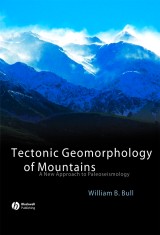Details

Tectonic Geomorphology of Mountains
A New Approach to Paleoseismology1. Aufl.
|
77,99 € |
|
| Verlag: | Wiley-Blackwell |
| Format: | |
| Veröffentl.: | 15.04.2008 |
| ISBN/EAN: | 9780470691557 |
| Sprache: | englisch |
| Anzahl Seiten: | 328 |
DRM-geschütztes eBook, Sie benötigen z.B. Adobe Digital Editions und eine Adobe ID zum Lesen.
Beschreibungen
With a balance of theory and practical applications, <i>Tectonic Geomorphology of Mountains</i> is essential reading for research geologists and upper-level undergraduate and graduate students in the earth sciences.<br /> <ul> <li style="list-style: none"><br /> </li> <li>This book describes how tectonic events influence geomorphic processes and explores how landscapes respond to tectonic deformation in the ways in which they are weathered, washed, and abraded<br /> </li> <li>Uses new approaches to enhance theoretical models of landscape evolution and to solve practical problems such as the assessment of earthquake hazards<br /> </li> <li>Includes previously unpublished research and theory<br /> </li> <li>Examines how to use key landforms as reference levels in changing landscapes, estimate rates of mountain-range uplift, and map seismic shaking caused by prehistorical earthquakes<br /> </li> <li>Presents a diverse range of examples from around the world</li> </ul>
Preface. <p><b>1 Scrunch and Stretch Bedrock Uplift</b>.</p> <p>1.1 Introduction.</p> <p>1.2 Pure Uplift, Stretch and Scrunch Bedrock Uplift.</p> <p>1.2.1 Isostatic and Tectonic Uplift.</p> <p>1.2.2 Stretch and Scrunch Tectonics.</p> <p>1.3 Landscape Responses to Regional Uplift.</p> <p><b>2 Concepts for Studies of Rising Mountains</b>.</p> <p>2.1 Themes and Topics.</p> <p>2.2 The Fundamental Control of Base Level.</p> <p>2.2.1 Base Level.</p> <p>2.2.2 Base Level Change.</p> <p>2.2.3 The Base Level of Erosion.</p> <p>2.2.4 The Changing Level of the Sea.</p> <p>2.2.5 Spatial Decay of the Effects of Local Base Level Changes.</p> <p>2.3 Threshold of Critical Power in Streams.</p> <p>2.3.1 Relative Strengths of Stream Power and Resisting Power.</p> <p>2.3.2 Threshold-Intersection Points.</p> <p>2.4 Equilibrium in Streams.</p> <p>2.4.1 Classification of Stream Terraces.</p> <p>2.4.2 Feedback Mechanisms.</p> <p>2.4.3 Dynamic and Static Equilibrium.</p> <p>2.5 Time Lags of Response.</p> <p>2.5.1 Responses to Pulses of Uplift.</p> <p>2.5.2 Perturbations that Limit Continuity of Fluvial Systems.</p> <p>2.5.3 Lithologic and Climatic Controls of Relaxation Times.</p> <p>2.5.4 Time Spans Needed to Erode Landforms.</p> <p>2.6 Tectonically-Induced Downcutting.</p> <p>2.6.1 Straths, Stream-Gradient Indices, and Strath Terraces.</p> <p>2.6.2 Modulation of Stream-Terrace Formation by Climatic Changes.</p> <p>2.7 Nontectonic Base-Level Fall and Strath Terrace Formation.</p> <p>2.8 Hydraulic Coordinates.</p> <p><b>3 Mountain Fronts.</b></p> <p>3.1 Introduction.</p> <p>3.2 Tectonically Active Escarpments.</p> <p>3.2.1 Faceted Spur Ridges.</p> <p>3.2.2 Mountain-Piedmont Junctions.</p> <p>3.2.3 Piedmont Forelands.</p> <p>3.3 Fault Segmentation of Mountain Fronts.</p> <p>3.3.1 Different Ways to Study Active Faults.</p> <p>3.3.2 Segmentation Concepts and Classification.</p> <p>3.3.3 Fault-Segment Boundaries.</p> <p>3.3.4 Normal Fault Surface Ruptures.</p> <p>3.3.5 Strike-Slip Fault Surface Ruptures.</p> <p>3.4 Summary.</p> <p><b>4 Tectonic Activity Classes of Mountain Fronts</b>.</p> <p>4.1 Tectonic Setting of the North America-Pacific Plate Boundary.</p> <p>4.2 Appraisal of Regional Mountain Front Tectonic Activity.</p> <p>4.2.1 Geomorphic Tools For Describing Relative Uplift Rates.</p> <p>4.2.1.1 Mountain-Front Sinuosity.</p> <p>4.2.1.2 Widths of Valleys.</p> <p>4.2.1.3 Triangular Facets.</p> <p>4.2.2 Diagnostic Landscape Classes of Relative Tectonic Activity.</p> <p>4.2.3 Regional Assessments of Relative Tectonic Activity.</p> <p>4.2.3.1 Response Time Complications and Strike-Slip Faulting.</p> <p>4.2.3.2 Maps of Relative Uplift.</p> <p>4.3 Summary.</p> <p><b>5 Fault Scarps</b>.</p> <p>5.1 General Features.</p> <p>5.2 Scarp Morphology Changes with Time.</p> <p>5.2.1 Changes in Scarp Height.</p> <p>5.2.2 Decreases in Maximum Scarp Slope.</p> <p>5.2.3 Diffusion-Equation Modeling.</p> <p>5.3 Climatic Controls of Fault-Scarp Morphology.</p> <p>5.4 Lithologic Controls of Fault-Scarp Morphology.</p> <p>5.4.1 Fault Rupture of Different Materials.</p> <p>5.4.2 Lithologic Controls on an 1887 Fault Scarp.</p> <p>5.4.2.1 Geomorphic Processes.</p> <p>5.4.2.2 Scarp Materials.</p> <p>5.4.2.3 Scarp Morphology.</p> <p>5.5 Laser Swath Digital Elevation Models.</p> <p>5.6 Dating Fault Scarps with Terrestrial Cosmogenic Nuclides.</p> <p>5.6.1 Alluvium.</p> <p>5.6.2 Bedrock.</p> <p>5.7 Summary.</p> <p><b>6 Analyses of Prehistoric Seismic Shaking</b>.</p> <p>6.1 Paleoseismology Goals.</p> <p>6.2 Earthquake-Generated Regional Rockfall Events.</p> <p>6.2.1 New Zealand Earthquakes.</p> <p>6.2.1.1 Tectonic Setting.</p> <p>6.2.1.2 Background and Procedures.</p> <p>6.2.1.3 Diagnostic Lichen-Size Peaks.</p> <p>6.2.1.3 Tree-Ring Analyses.</p> <p>6.2.1.5 Alpine Fault Earthquakes.</p> <p>6.2.1.6 Recent Marlborough Earthquakes.</p> <p>6.2.2 California Earthquakes.</p> <p>6.2.2.1 Calibration of Lichen Growth Rates.</p> <p>6.2.2.2 Recent Cliff Collapse.</p> <p>6.2.2.3 Rockfall Processes in Glaciated Valleys.</p> <p>6.2.2.4 San Andreas Fault Earthquakes.</p> <p>6.2.2.5 Lichenometry and Precise Radiocarbon Dating Methods.</p> <p>6.3 Summary.</p> <p>References Cited.</p> <p>Index</p>
"The writing style is conversational and familiar and the text is sprinkled with numerous vignettes from the author′s long and distinguished career.... Exhaustive descriptions complemented by abundant simple, clear illustrations form the core of each chapter." (<i>Geographical Journal</i>, September 2008) <p>"The book contains numerous excellent examples to illustrate the concepts introduced in the text … .An excellent advanced textbook that should be widely read by all geologists interested in the interaction of active tectonics and landscapes." (<i>Geoscientist</i>, January 2009)</p>
<b>William B. Bull</b> is an applied geologist educated at Colorado and Stanford Universities. He worked 12 years for the US Geological Survey as an engineering geologist and groundwater hydrologist. Studies of collapsing soils and land subsidence were quite appealing, but he changed career goals by moving to the University of Arizona where he taught geomorphology for 28 years. He continues to study landscapes of rising mountains from the perspective of earthquake hazards.
This book explores how landscapes respond to tectonic deformation.<br /> <p><br /> </p> <p>Including much previously unpublished research and theory, <i>Tectonic Geomorphology of Mountains</i> uses new approaches to enhance theoretical models of landscape evolution and to better assess hazards caused by earthquakes. Readers will learn how to use key landforms as diagnostic indicators of changing landscapes, to estimate rates of mountain-range uplift, and use landslide sensitivity to earthquakes to map the locations and intensity of prehistorical seismic shaking.<br /> </p> <p><br /> </p> <p>Examples from around the world illustrate diverse landscapes, from the humid Southern Alps of New Zealand with phenomenal rates of uplift and erosion to the semi-arid Panamint Range of southeastern California with such miniscule annual stream power that tectonic landforms persist for millions of years.<br /> </p> <p><br /> </p> <p>With a balance of theory and paleoseismology applications, <i>Tectonic Geomorphology of Mountains</i> is essential reading for research geologists and upper-level undergraduate and graduate students in the earth sciences.</p>

















